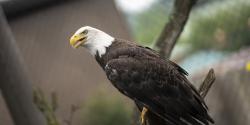Slick, sly, and elusive – the eastern hellbender is a unique and endangered amphibian native to midwestern streams. As an indicator species, these giant salamanders play a key role in our ecosystem; their presence (or absence) can tell us a lot about the quality of our streams and rivers. Unfortunately, their population has declined sharply due to habitat degradation and pollution.
Recently, I had the incredible opportunity to take part in a conservation milestone: releasing hellbenders into their native range. This effort was led by The Wilds in collaboration with several partner organizations dedicated to restoring natural ecosystems. Through collaborative conservation efforts, we can help protect these remarkable creatures and ensure they thrive for generations to come.
Release Day
The day started early, with a few hours of travel to meet with the field team at the release site. Volunteers ranged from novices to experts, and after a brief rundown of the day’s activities, we headed to the stream to begin our work.

Our first task: find rocks that worked as potential release sites.
While it may not sound like the coziest home, rocks are the perfect shelter for a hellbender, the introverts of the river. With their flat bodies, webbed toes, and wrinkly skin, hellbenders thrive in rocky riverbeds where they can hide, camouflaged, waiting for crayfish and small fish to swim by. Though it sounds simple, finding suitable rocks was actually the most difficult portion of our day! Once we found the ideal sites, hellbenders were scanned for future monitoring, then gently placed into their new homes. Watching them glide into the water was both exciting and oddly adorable. One even poked its head out to explore its new surroundings, which made for a heartwarming moment (though we gently nudged it back under its rock!).
Importance of Hands-On Conservation
This release was just one small part of an ongoing effort in Ohio and West Virginia streams. The Columbus Zoo and The Wilds have been involved in hellbender rearing, research, and releases for over three decades as part of the Ohio Hellbender Partnership. The 48 hellbenders released that day are only a small portion of the more than 1,000 released by the Zoo and more than 400 released by The Wilds. These particular hellbenders were born in 2019 and 2020, showing just how long restoration efforts can take.
Through this hands-on experience, I learned how patience and persistence are essential in conservation. Connecting with the other volunteers reminded me that no matter what our roles, we all shared the same passion: protecting wildlife and their habitats. This was not only a release, but a celebration of collaboration, science, and the shared goal of saving wildlife. It felt truly special to embody the Columbus Zoo’s mission of Empowering People. Saving Wildlife.
How Can You Help Hellbenders?
- Be mindful of your impact: Keep in mind that everything we use in our daily lives can eventually end up in a river or an ocean. When choosing bug sprays, sunscreens, fertilizers, etc., look closely at the product labels and ingredients to ensure they are safe for our environment. Small choices can have a big impact, and by making more sustainable choices, we can help protect our waterways and the species that depend on them.
- Support conservation organizations: Consider donating or visiting organizations like the Columbus Zoo or The Wilds, whose efforts are directly contributing to the restoration of the hellbender population. The Hellbender RV Campground at The Wilds is a great way to enjoy nature and support this species. If you would like to see a hellbender up close and personal, I encourage you to come check out the Ohio Center for Wildlife Conservation’s visitor building at the Columbus Zoo. There, you will get to see what goes on behind the scenes in hellbender rearing and learn about other projects the Zoo is supporting across Ohio.
- Use your voice: Talk about hellbenders! If you didn’t know what one was before reading this article, you are not alone. Many people have never heard of them, which is why it's so important to spread the word. The more people that know about them, the better we can protect them!
Helping these hellbenders find their place in the wild was a special moment. No matter the creature, from the slimy salamanders to the cute and furry, every animal species is crucial to sustain biodiversity around the world. We are all interconnected, and it is important that we take actions, both big and small, to save these species. I am so grateful to have had this experience and to be part of this ongoing conservation story. I look forward to a future where hellbenders are thriving in our local waters once more.









